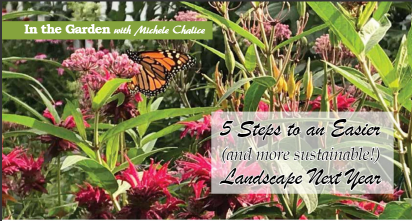The morning air is cooler now. You know it’s getting to be late summer, and we’re beginning to think about, don’t say it, Fall. You’ve mowed the lawn, picked vegetables, and cut flowers to bring inside all season, or not. Now is a great time to think about what went well in your landscape and/or garden. What did you enjoy? And what did you really not enjoy these past months? Here is a list of five suggestions and actions that you can take now to have a more enjoyable landscape next year.
First – ‘Set the Stage’ – Are you providing for the activities you want in your landscape? Grilling? Relaxing? Play? Now is a great time to re-evaluate the physical aspects that provide for how you use your landscape. Start with one activity that would you bring more enjoyment to your space. Don’t ignore the fact that a particular area is too wet or too dry during part of the season. Make sure to locate the new aspect with convenience in mind.
Second – Determine how much time you like to spend on landscape tasks. Not much? That’s alright.
Plant more native shrub areas on the outside of your yard in ‘ribbons’ or groupings. Well-spaced shrubs ‘read’ like an organized, tended landscape over time. They take up space and reduce your amount of grass. Many native shrubs also feed fruit and seeds to birds, providing exciting leaf textures and fall colors. If you choose native shrubs, they won’t need to be watered after becoming established. They survive our weather, not needing to be replaced.
Mow Less! Overseed your grass with a Bee-Lawn seed mix. Mowing every two to three weeks at a 3” height even on a regular lawn increases the number of tiny, low flowers, which offer habitat and nutrition for an increased number of pollinators!
Third – Choose landscape and/or garden changes in locations that you see often and particularly from windows inside your home. Sure we have areas we think we’re supposed to spend money on but using this strategy reaps a double benefit. Planting a ‘pollinator patch’ that you can see from where you drink your earliest cup of coffee can bring more daily joy.
Fourth – Stop fighting for your lawn. You’ve seen the vast expanses of burnt grass in your neighborhood. Lawns are an expensive, destructive, time-consuming obsession that came with many of us from 1700’s Europe. Lawns are not American landscapes. Forests, prairies, wetlands, mountains, and meadows are American landscapes. Lawns are not even healthy. A “Tufts six-year study found that the use of lawn pesticides was associated with a greater risk of canine (aka, man’s best friend) malignant lymphoma (CML)”. Shifting gears to plant native plants can add your landscape to the new, “Homegrown National Park” map, or creating your own designated, Wildlife Habitat with the National Wildlife Federation can be a much healthier and more rewarding way to find delight and join others.
Fifth – Decide you want less…
Less weeding by planting ‘green mulch’ = native groundcover plants that block sunlight from reaching weed seeds.
Less cost – the Farmer’s Almanac estimates that “The leaves of one large tree can be worth as much as $50 worth of plant food and humus. Pound for pound, leaves contain twice the mineral content of manure.” Your fall leaves are free!
Less watering – laying a 3” ‘blanket’ of this year’s fall leaves, shredded by mowing, at the base of all of your plantings conserves moisture and reduces evaporation and the need for watering.
Less stress – Seeing a pretty anything, flower, bird, or leaf, in my own yard helps me breathe more deeply. You too? “…It would be hard to overestimate the value of time spent outdoors. Sunshine boosts vitamin D production which helps our bodies function more efficiently while the simple act of being out in the natural world increases serotonin levels, promoting calm and reducing stress.
Thinking through and acting on any of these five steps can be an effective way for next year’s landscape/garden to bring you more enjoyment and even more peace of mind. You can choose actions that will mean less mowing, watering, and weeding. Choosing other steps will result in seeing more pollinators in your yard as well as more seasonal changes, color, and textures. Planning and planting this fall can mean more play in your yard and/or feeding the songbirds you love from native shrubs instead of bags of seeds that endanger bears. Your efforts now can create more joy next season because your yard will now have more of what makes you happy.
RESOURCES:
https://www.nrs.fs.fed.us/urban/landscape_change/bee-habitat/
https://homegrownnationalpark.org/
https://www.nwf.org/CERTIFY
https://www.almanac.com/more-ways-use-fall-leaves-garden
https://www.webmd.com/mental-health/how-gardening-affects-mental-health#:~:text=Gardening%20can%20make%20you%20feel,Boosts%20self%2Desteem.
Michele Chalice is an environmental landscape designer and owner of Keene-based Healthy Home Habitats (HHH); your source for healthier, creative landscape designs for home landscapes. HHH helps people transform their landscapes into yardens for more color, more health, and more pollinator habitat in NH’s Monadnock region. You can find HHH at www.HealthyHomeHabitats, on Facebook, LinkedIn, and Instagram.

